Takeaways
- Phospholipids form cell membranes and help transport cholesterol
- They work with cholesterol to maintain membrane fluidity
- Dietary phospholipids may help lower blood cholesterol levels
- Phospholipids aid in cholesterol removal from cells
- Understanding this relationship is vital for heart and brain health
Understanding Phospholipids
Phospholipids are small molecules forming the outer layer of our cells, called cell membranes.[1] They have a unique structure, with a water-attracting (hydrophilic) head and two water-repelling (hydrophobic) tails.[2] This allows them to create a barrier by arranging themselves into a double layer, with the heads facing outward and tails inward.[3]
Beyond forming cell barriers, phospholipids are involved in many body functions.[4] They help move substances into and out of cells, assist in cell communication, and serve as an energy source.[5] These functions highlight their importance in cellular operations.
Several kinds of phospholipids exist in our bodies, including phosphatidylcholine, phosphatidylethanolamine, and sphingomyelin.[6] Each type has slightly different characteristics and functions. For example, phosphatidylcholine, found in abundance in cell membranes, aids in the metabolism of fats.[7]
Composition and Structure
Phospholipids consist of a head and two tails.[8] The head contains a phosphate group and a polar molecule, which is attracted to water.[9] The tails are made of fatty acids, which avoid water.[10] These distinct parts give phospholipids their unique properties.
The arrangement of phospholipids in cell membranes is due to their structure.[11] The water-loving heads point toward the watery environments inside and outside the cell, while the water-repelling tails face inward.[12] This forms a stable barrier that shields the cell.
Key components of a phospholipid molecule include: a phosphate group, a polar molecule (forming the head), and two fatty acid chains (forming the tails).[13]
- Phosphate group
- Polar molecule (like choline or ethanolamine)
- Glycerol backbone
- Two fatty acid tails
Functions in the Body
Phospholipids play vital roles beyond forming cell membranes.[14] They aid in the absorption and transport of fats within the bloodstream, assist in the transmission of nerve signals, and support proper liver function.[15] These diverse roles demonstrate their importance to overall health.
In digestion, phospholipids help break down fats by forming small droplets called micelles.[16] These micelles allow fats to mix with water, which is necessary for proper digestion and the absorption of nutrients.[17]
Phospholipids are also important for brain health.[18] They constitute a large portion of brain tissue and help protect nerve fibers.[19] Some research suggests certain phospholipids may improve memory and thinking skills.[20]
| Body System | Function of Phospholipids |
|---|---|
| Digestive | Aid in fat breakdown and absorption |
| Nervous | Support nerve signal transmission |
| Circulatory | Help transport fats in blood |
| Immune | Assist in cell signaling |
| Respiratory | Reduce surface tension in lungs |
Cholesterol Basics
Cholesterol, while often seen negatively, is essential for our bodies.[21] It’s a waxy substance in every cell membrane and is used to create hormones, vitamin D, and substances that aid digestion.[22] It is a key molecule for various bodily processes.
Two main types of cholesterol circulate in our blood: LDL (low-density lipoprotein) and HDL (high-density lipoprotein).[23] LDL, often called “bad” cholesterol, can contribute to plaque buildup in arteries.[24] HDL, known as “good” cholesterol, helps remove excess cholesterol from the bloodstream.[25]
Our body produces most of the cholesterol it needs, primarily in the liver.[26] We also get some cholesterol from food, particularly animal products.[27] The body regulates cholesterol levels carefully to maintain a proper balance.
Types of Cholesterol
LDL cholesterol transports cholesterol from the liver to cells.[28] Excess LDL in the blood can accumulate on artery walls, creating plaque.[29] This buildup can narrow arteries and increase the risk of heart disease.
HDL cholesterol has a beneficial role, acting like a scavenger to remove excess cholesterol from the bloodstream and carry it back to the liver.[30] The liver then removes this cholesterol from the body. Higher HDL levels are associated with a reduced risk of heart disease.
Besides LDL and HDL, other lipoproteins, like VLDL (very low-density lipoprotein) and IDL (intermediate-density lipoprotein), also transport cholesterol.[31] Each type of lipoprotein plays a role in moving fats and cholesterol through the bloodstream.
Cholesterol Synthesis
Our body synthesizes cholesterol through a complex process, mainly in the liver.[32] It involves multiple steps and enzymes. This process is carefully regulated to ensure we have enough cholesterol, without excessive levels.
The liver produces cholesterol based on the body’s needs.[33] If we eat less cholesterol, the liver produces more, and vice versa.[34] This regulation helps maintain balance. However, genetic factors or lifestyle habits can cause some people to overproduce cholesterol.
Key steps in cholesterol synthesis include: the conversion of acetyl-CoA to mevalonate, followed by a series of enzymatic reactions that ultimately form cholesterol.[35]
- Acetyl-CoA formation
- HMG-CoA synthesis
- Mevalonate production
- Isoprenoid formation
- Squalene synthesis
- Cholesterol production
Phospholipids and Cholesterol Interaction
Phospholipids and cholesterol work closely together in our bodies, particularly within cell membranes.[36] They cooperate to maintain the proper fluidity of the membrane.[37] This teamwork is important for proper cell function.
In cell membranes, phospholipids form a double layer, with cholesterol molecules fitting between the tails of the phospholipids.[38] This arrangement helps control the membrane’s fluidity or rigidity.[39] Maintaining the right balance is essential for cells to operate correctly.
The interaction between phospholipids and cholesterol impacts several cellular processes, influencing how easily substances move into or out of cells.[40] It also affects how cells respond to signals from their surroundings. Understanding this interaction is important for comprehending cellular function and health.
Membrane Composition
Cell membranes are intricate structures, with phospholipids and cholesterol as key components.[41] The phospholipid bilayer forms the fundamental structure. Cholesterol molecules insert themselves among the phospholipid tails.
The amount of cholesterol within cell membranes varies depending on the cell type.[42] For example, nerve cells have more cholesterol than red blood cells. This variability affects the membrane’s properties, impacting how the cells operate.
Cholesterol serves several purposes within the membrane. It helps maintain membrane fluidity across different temperatures.[43] It also strengthens the membrane and reduces its permeability to small water-soluble molecules.[44]
| Cell Type | Phospholipid Content | Cholesterol Content |
|---|---|---|
| Neuron | High | High |
| Liver Cell | Moderate | Moderate |
| Red Blood Cell | Low | Low |
Lipid Rafts
Lipid rafts are specialized regions within cell membranes, similar to small islands within a sea.[45] These areas are rich in cholesterol and particular types of phospholipids and are involved in various cellular processes.[46]
Cholesterol is essential for creating lipid rafts.[47] It helps establish a more organized environment within these rafts. This structure enables certain proteins to cluster together. These clusters are involved in cell signaling and other key functions.[48]
Lipid rafts perform diverse functions within cells. They help organize signaling molecules, improving cellular communication.[49] They are also involved in the entry of some viruses and bacteria into cells.[50] Studying lipid rafts can provide insights for disease treatments.
Phospholipids and Cholesterol Transport
Phospholipids play a key role in the movement of cholesterol throughout the body.[51] They are essential parts of lipoproteins, which transport cholesterol.[52] Lipoproteins act as tiny vehicles, carrying cholesterol and other fats in the bloodstream.
Several types of lipoproteins exist, each with varying combinations of proteins and lipids.[53] These compositions determine their specific functions in the body. Some lipoproteins deliver cholesterol to cells, while others remove excess cholesterol.[54]
Understanding how phospholipids aid in cholesterol transport is important for understanding how the body maintains cholesterol balance. This knowledge can help develop improved methods for managing cholesterol levels and promoting heart health.
Lipoprotein Structure
Lipoproteins are complex particles with a core of fats and cholesterol, surrounded by a layer of phospholipids and proteins.[55] This phospholipid layer enables the lipoproteins to mix with blood, which is mainly water.[56]
Phospholipids are critical in the formation of lipoproteins.[57] They help shape the particles and keep the fats and cholesterol contained within. Without phospholipids, these important transporters would not function correctly.
Key components of a lipoprotein particle include: a core of cholesterol and triglycerides, surrounded by a layer of phospholipids and proteins (apolipoproteins).[58]
- Phospholipid outer layer
- Protein components (apolipoproteins)
- Cholesterol molecules
- Triglycerides (in some types)
Cholesterol Efflux
Cholesterol efflux is the process of removing excess cholesterol from cells.[59] This is a crucial part of maintaining healthy cholesterol levels. Phospholipids play a key role in this removal process.
When cells have too much cholesterol, they need to eliminate it. They do this by transferring cholesterol to high-density lipoproteins (HDL).[60] Phospholipids within HDL particles help receive this cholesterol, creating space for it within the lipoprotein’s structure.[61]
This process is part of what is called reverse cholesterol transport.[62] HDL carries excess cholesterol to the liver, which removes it from the body.[63] This is why HDL is known as “good” cholesterol; it helps regulate cholesterol levels.
Dietary Sources and Supplementation
Our diet influences our phospholipid and cholesterol levels.[64] Certain foods are naturally rich in phospholipids.[65] Consuming these foods can potentially help manage cholesterol levels. It is also possible to obtain phospholipids from supplements.
Diet significantly affects cholesterol levels. Foods high in saturated fats tend to increase blood cholesterol.[66] Conversely, foods rich in unsaturated fats and phospholipids may help lower it.[67] A balanced diet is key to maintaining healthy cholesterol levels.
Phospholipid supplements are available in different forms.[68] Some people use them to try to lower cholesterol or improve liver health.[69] While some studies show possible benefits, more research is needed.[70] It’s always best to consult a healthcare provider before using any supplement.
Food Sources
Many foods contain phospholipids. They are especially abundant in certain animal products and some plant-based foods.[71] Eating a variety of these foods can help ensure a sufficient intake of phospholipids.
Cooking methods can affect the phospholipid content of foods.[72] High heat can break down some phospholipids. Using gentler methods like steaming or light sautéing can help preserve more of these helpful compounds.
Common food sources of phospholipids include: egg yolks, soybeans, sunflower seeds, fish, and organ meats.[73]
- Egg yolks
- Soybeans and soy products
- Sunflower seeds
- Peanuts
- Organ meats (like liver)
- Fish (especially fatty fish)
- Whole grains
Supplementation Options
Several types of phospholipid supplements are available. The most common is lecithin, which is high in phosphatidylcholine.[74] Other supplements include isolated phosphatidylserine or phosphatidylcholine.
These supplements may have various benefits. Some research suggests they could help lower cholesterol or improve liver function.[75] However, these results are not consistent, and more research is needed to fully confirm these effects.
When considering phospholipid supplements, it’s important to be cautious.[76] They can interact with some medications. They also may cause side effects in some people.[77] Always consult a healthcare provider before starting any new supplement.
Health Implications
The balance of phospholipids and cholesterol in our bodies affects our health.[78] An imbalance can lead to different health problems. Understanding these effects can help us make better health choices.
Imbalances in phospholipids and cholesterol are linked to several conditions. These include heart disease, liver problems, and certain neurological disorders.[79] However, many of these conditions are preventable through lifestyle management.
Maintaining a healthy balance involves several strategies. Diet is crucial, as is regular exercise.[80] Sometimes medication is necessary. Working with a healthcare provider is helpful to determine the best approach for each person.
Cardiovascular Health
The connection between phospholipids, cholesterol, and heart health is significant.[81] High levels of LDL cholesterol can lead to plaque buildup in arteries. This condition, called atherosclerosis, increases the risk of heart attacks and strokes.[82]
Phospholipids, particularly those in HDL particles, help remove excess cholesterol from arteries.[83] This process can slow down or even reverse plaque formation. It explains why high HDL levels are considered beneficial for heart health.
To maintain cardiovascular health, it is important to manage cholesterol levels.[84] This usually involves lifestyle changes such as a heart-healthy diet, regular exercise, and avoiding smoking. In some cases, medication may be necessary.
Cognitive Function
Phospholipids and cholesterol are plentiful in the brain. They are key parts of brain cell membranes. Their balance can influence cognitive function and overall brain health.
Some studies suggest certain phospholipids might improve memory and cognitive function. For example, phosphatidylserine supplements have shown promise in some trials. However, more research is needed for confirmation.
Cholesterol also supports brain function. It is needed for forming synapses, which are the connections between brain cells. However, high blood cholesterol levels may increase the risk of cognitive decline later in life. A healthy balance is important for long-term brain health.
Research and Future Directions
Ongoing research is investigating phospholipids and cholesterol. Scientists are exploring how these molecules interact and affect our health. This research could lead to new treatments for various conditions.
One area of focus is the role of specific phospholipids in health and disease. For example, research is being conducted on how phosphatidylcholine levels relate to liver health. Other studies are examining the effects of phosphatidylserine on brain function.
Researchers are also exploring new ways to manage cholesterol levels. This includes developing drugs that target phospholipid metabolism. The aim is to find more effective treatments for high cholesterol and related conditions.
Emerging Therapies
New treatments that target phospholipid-cholesterol interactions are being developed. Some of these treatments aim to enhance the body’s natural cholesterol removal processes. Others focus on changing how cells handle cholesterol.
Gene therapies are an exciting area of research. Scientists are exploring ways to alter genes involved in lipid metabolism. This could potentially correct inherited cholesterol disorders. However, these therapies are still in early development.
Personalized medicine approaches are emerging, taking into account an individual’s genetics and lifestyle. The goal is to tailor treatments for the best outcomes. As research continues, we may see more targeted therapies for managing cholesterol and related health issues.
FAQ
In conclusion, phospholipids and cholesterol are essential components of our bodies. They work together to maintain cell membranes, transport fats, and support various bodily functions. Understanding their interaction can help us make informed health choices. A balanced diet rich in natural sources of phospholipids, combined with regular exercise, can help maintain healthy cholesterol levels. While supplements may be beneficial for some, consulting a healthcare provider before starting any new regimen is always recommended. As research advances, we may discover new ways to use the phospholipid-cholesterol relationship to improve health. Currently, focusing on overall healthy lifestyle choices remains the best approach for most people. Remember, everyone’s body is different. What works for one person may not work for another. Working with healthcare providers to develop a personalized approach for managing cholesterol and overall health is important. By understanding the roles of phospholipids and cholesterol, we can proactively improve our health. This knowledge empowers us to make better decisions about our diet, lifestyle, and healthcare options.What are phospholipids?
How do phospholipids affect cholesterol levels?
Can phospholipid supplements lower cholesterol?
What foods are high in phospholipids?
Are phospholipids good or bad for you?
How do phospholipids and cholesterol work together in the body?
What’s the difference between phospholipids and triglycerides?
Can phospholipids help with weight loss?
Phospholipids are indeed the fundamental building blocks of cell membranes, creating the lipid bilayer that forms the outer boundary of cells.
This amphipathic nature of phospholipids, with a polar head and nonpolar tails, is essential for their role in forming biological membranes.
The arrangement of phospholipids into a bilayer is due to their amphipathic properties. Hydrophilic heads interact with water, while hydrophobic tails cluster together away from water.
Phospholipids are not just structural components, they are involved in various cellular processes like cell signaling and lipid transport.
While phospholipids are involved in membrane transport and cell signaling, they are not a primary source of energy for the cell. Carbohydrates and fats are the main energy sources.
Phosphatidylcholine, phosphatidylethanolamine, and sphingomyelin are among the most abundant phospholipids in cell membranes.
Phosphatidylcholine plays a role in fat transport and metabolism, including the formation of lipoproteins which carry fats in the blood.
Source: “Time-resolved small-angle neutron scattering as a probe for the dynamics of lipid exchange between human lipoproteins and naturally derived membranes” https://www.ncbi.nlm.nih.gov/pmc/articles/PMC6527577/
This arrangement gives phospholipids their characteristic amphipathic nature and allows them to form bilayers.
The phosphate group and polar molecule give the phospholipid head its hydrophilic properties, allowing it to interact with water.
The fatty acid tails are nonpolar and hydrophobic, meaning they avoid water and tend to cluster together.
The amphipathic nature of phospholipids drives their self-assembly into a bilayer structure in aqueous environments, forming the basis of cell membranes.
This arrangement minimizes contact between the hydrophobic tails and water while maximizing interaction between the hydrophilic heads and water-based cellular environments.
These three components are fundamental to the structure and function of phospholipids.
Beyond membrane structure, phospholipids are involved in various cellular processes including lipid transport and cell signaling.
Phospholipids are crucial in the formation of lipoproteins that transport fats, are components of the myelin sheath surrounding nerves and are also important for liver health.
Micelles formed by phospholipids help emulsify fats, making them more accessible for digestion and absorption.
This emulsification process is crucial because fats are not water-soluble, and this process is needed for their absorption in the intestines.
Phospholipids are key components of brain cell membranes and play a role in nerve signal transmission and overall brain health.
Phospholipids are essential for brain cell membranes and are also a key part of myelin sheaths, which insulate and protect nerve fibers.
Some studies on specific phospholipids like phosphatidylserine suggest potential cognitive benefits, but more research is needed to fully establish the extent of these effects.
Source: “Phosphatidylserine Supplementation as a Novel Strategy for Reducing Myocardial Infarct Size and Preventing Adverse Left Ventricular Remodeling” https://www.ncbi.nlm.nih.gov/pmc/articles/PMC8122843/
Despite its negative association, cholesterol is a crucial component of cell membranes and is needed for producing hormones and vitamin D.
Cholesterol is a structural component of cell membranes, a precursor for steroid hormones and vitamin D and also needed to produce bile acids, important for digestion.
These are the most commonly discussed types of lipoproteins, responsible for carrying cholesterol in the bloodstream.
Elevated LDL cholesterol can deposit in artery walls, forming plaques that can lead to atherosclerosis.
HDL transports cholesterol from peripheral tissues back to the liver for excretion, a process known as reverse cholesterol transport.
The liver is the main organ for cholesterol synthesis, producing most of the cholesterol needed by the body.
Foods of animal origin, such as meat, eggs and dairy contain dietary cholesterol.
LDL particles deliver cholesterol to various tissues throughout the body.
This plaque buildup can cause atherosclerosis, increasing the risk of cardiovascular disease.
HDL transports excess cholesterol back to the liver where it can be processed and removed from the body.
VLDL and IDL are also involved in carrying lipids and cholesterol through the bloodstream.
Cholesterol synthesis involves multiple enzymatic steps, mainly taking place in the liver.
The liver has feedback mechanisms to regulate cholesterol synthesis to maintain balance.
This feedback mechanism helps maintain a relatively constant level of cholesterol in the body.
The mevalonate pathway, beginning with acetyl-CoA, is essential for the synthesis of cholesterol.
The interaction between these lipids is crucial for the structure and function of cell membranes.
Cholesterol regulates membrane fluidity in response to temperature, while phospholipids form the basic structure of the membrane.
Cholesterol molecules insert themselves among the hydrophobic tails of the phospholipids, contributing to membrane stability and fluidity.
The proportion of cholesterol relative to phospholipids in a membrane affects its fluidity and rigidity. Cholesterol acts as a buffer, preventing drastic changes in fluidity due to temperature changes.
Membrane fluidity affects permeability, thus, the transport of substances into and out of cells is influenced by the interaction between these lipids.
These two lipids are major components of cell membranes, contributing to their structural integrity and function.
Different cell types have varying cholesterol levels in their membranes to suit their specific functions.
Cholesterol buffers changes in temperature, preventing membranes from becoming too rigid at low temperatures and too fluid at high temperatures.
The presence of cholesterol in the membrane makes it more structurally stable and less permeable to small molecules.
These microdomains are different from the rest of the membrane, due to their specific lipid composition.
Lipid rafts are enriched with cholesterol, sphingolipids and certain proteins, and are involved in a variety of functions including signal transduction.
Cholesterol’s unique structure allows it to pack tightly with sphingolipids, promoting the formation of lipid rafts.
Lipid rafts are involved in organizing signaling molecules and facilitating many cellular functions, including signal transduction.
By clustering specific proteins, lipid rafts enhance cell signaling efficiency.
Some pathogens exploit lipid rafts to gain entry into cells during the infectious process.
Phospholipids are integral to the structure of lipoproteins, the particles that transport cholesterol and other lipids in the blood.
Lipoproteins require phospholipids in their outer layer to make them water-soluble and able to transport fats throughout the body.
Lipoproteins are classified by their density and vary in their ratio of proteins to lipids.
LDL delivers cholesterol to cells while HDL removes excess cholesterol from the body.
This structure allows lipoproteins to transport hydrophobic lipids through the aqueous environment of the bloodstream.
The hydrophilic heads of the phospholipids in the lipoprotein surface interact with water, making the entire particle soluble in blood.
Phospholipids are essential components of the surface layer of lipoproteins, enabling their function and transport.
The core contains hydrophobic lipids, and the surface has phospholipids and apolipoproteins, which are necessary for their functionality.
This process is crucial for maintaining cholesterol homeostasis and preventing cellular cholesterol buildup.
This transfer is the first step in reverse cholesterol transport which returns cholesterol to the liver.
Phospholipids help structure the HDL particle to enable the incorporation of cholesterol molecules.
Reverse cholesterol transport is the process of removing cholesterol from peripheral tissues back to the liver for excretion.
The liver then processes and removes excess cholesterol via bile.
The type of fats, cholesterol, and phospholipids consumed can affect blood levels of these lipids.
Foods like egg yolks, soybeans, and organ meats are natural sources of phospholipids.
Saturated fats are known to increase LDL cholesterol levels in the blood.
Unsaturated fats are known to improve cholesterol levels. Some studies have suggested that certain phospholipids may help lower cholesterol levels, but more research is needed to confirm these effects.
Phospholipid supplements include lecithin, phosphatidylserine, and phosphatidylcholine.
These supplements are used by some due to suggestions of positive effects on blood cholesterol levels and liver health.
Existing studies have had mixed results, so further robust research is necessary before making strong recommendations.
Phospholipids are components of both animal and plant cells.
High temperatures can break down some phospholipids, affecting their nutritional value.
These foods contain higher amounts of phospholipids than many other foods.
Lecithin is often used as a supplement and is rich in phosphatidylcholine.
Some studies have suggested positive impacts of phospholipid supplements on cholesterol levels and liver health, but more consistent evidence is needed.
It is important to be cautious when taking supplements, due to possible side effects and drug interactions.
Phospholipid supplements can interact with some medications and may cause side effects like stomach upset in some people.
Maintaining a healthy balance between phospholipids and cholesterol is important for overall health.
Imbalances in phospholipid and cholesterol levels are associated with many conditions, including heart disease and liver disease.
Lifestyle factors like diet and exercise play a key role in managing phospholipid and cholesterol levels.
The interplay of these lipids is crucial in cardiovascular health. Maintaining a healthy balance is essential for preventing cardiovascular disease.
Elevated LDL contributes to plaque accumulation in arteries, leading to cardiovascular disease.
Phospholipids are a key component of HDL which facilitates the removal of excess cholesterol from artery walls.
Controlling cholesterol levels through lifestyle and medical interventions can reduce the risk of cardiovascular disease.



